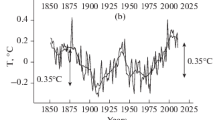Abstract
The gravitational influence of Jupiter on Saturn produces, among other things, non-negligible changes in the eccentricity of Saturn that affect the magnitude of error of Ptolemaic astronomy. The value that Ptolemy obtained for the eccentricity of Saturn is a good approximation of the real eccentricity—including the perturbation of Jupiter—that Saturn had during the time of Ptolemy's planetary observations or a bit earlier. Therefore, it seems more probable that the observations used for obtaining the eccentricity of Saturn were done near Ptolemy’s time, and rather unlikely earlier than the first century AD. Even if this is not quite a demonstration that Ptolemy used observations of his own, my argument increases its probability and practically discards the idea that Ptolemy borrowed values or observations from astronomers further back than the first century AD, such as Hipparchus or the Babylonians.













Similar content being viewed by others
Notes
For an account of the discovery of the perturbations see (Wilson 1985). I follow Wilson in the qualitative explanation of the change of the mean speed. I am grateful to Hernán Grecco for his explanation of the change in the eccentricity; Hernán has also produced for me the data for building the chart with the change of the instant (perturbed) eccentricity of Saturn over time.
In order to obtain these values, I randomly added a value between ± 12 h to the correct time and a value between ± 15′ to the correct longitude to each of the 16 oppositions. I then calculated the average and standard deviation of the found eccentricities. I repeated this process 50 times. The final values are the average of the 50 tries. In all cases, I omitted the trios including two consecutive oppositions because in these cases a small error produces inaccurate results and Ptolemy was, almost certainly, aware of it.
Ptolemy says in Almagest IX.2 that even if Hipparchus did not develop planetary models, he made a compilation of planetary observations arranged in a more useful way. It is not clear whether this compilation included his own observations or not. Ptolemy also says that Hipparchus used these observations to show that the phenomena were not in agreement with the hypotheses of the astronomers of his time (Toomer 1998, 421).
There are at least two reasons that make it impossible to find vestiges of the gravitational perturbation of Saturn on Jupiter. On the one hand, the change of Jupiter is smaller than that of Saturn. On the other, given that Jupiter’s tropical period is around 12 years, Ptolemy (or whoever calculated the eccentricity) could use observations of oppositions uniformly distributed along the entire zodiac, obtaining a value for the eccentricity closer to the Keplerian one. The mean value of Jupiter’s eccentricity during the Ptolemaic epoch is, including Jupiter’s perturbation, around 5.42 parts; the same value applies to the Hipparchian epoch, and around -250 diminishes to 2.35 parts. The difference is too small to be detected.
References
Aaboe, Asger. 2001. Episodes from the Early History of Astronomy. New York: Springer.
Carman, Christián C., and Gonzalo L. Recio. 2019. Ptolemaic Planetary Models and Kepler’s Laws. Archive for History of Exact Sciences 73 (1): 39–124. https://doi.org/10.1007/s00407-018-0219-x.
Duke, Dennis. 2005. Ptolemy’s Treatment of the Outer Planets. Archive for History of Exact Sciences 59 (2): 169–187. https://doi.org/10.1007/s00407-004-0086-5.
Duke, Dennis. 2009. Mean Motions in Ptolemy’s Planetary Hypotheses. Archive for History of Exact Sciences 63 (6): 635–654. https://doi.org/10.1007/s00407-009-0049-y.
Evans, James. 1984. On the Function and Probable Origin of Ptolemy’s Equant. American Journal of Physics 52: 1080–1089.
Goldstein, Bernard R. 1967. The Arabic Version of Ptolemy’s Planetary Hypotheses. Transactions of the American Philosophical Society 57 (4): 3–55.
Hamilton, N. T., N. M. Swerdlow, and G. J. Toomer. 1987. ‘The Cannobic Inscription, Ptolemy’s Earliest Work’. In From Ancient Omens to Celestial Mechanics, eds. J. L. Berggren and B. R Goldstein, Copenhagen, 55–73.
Hamm, Elizabeth. 2011. ‘Ptolemy’s Planetary Theory: An English Translation of Book One, Part A of the Planetary Hypotheses with Introduction and Commentary’. Ph.D., University of Toronto, Toronto.
Jones, Alexander. 2005. Ptolemy’s Canobic Inscription and Heliodorus’ Observation Reports. SCIAMVS 6: 53–97.
Mercier, Raymond. 2011. Πτολεμαίου Πρόχειροι Kανόνες. Ptolemy’s Handy Tables, Volume 1b. Tables A1–A2. Transcription and Commentary. Publications de l’Institut Orientaliste de Louvain. Louvain-la-Neuve: Université Catholoque de Louvain, Institut Orientaliste, Louvain-la-Neuve.
Swerdlow, Noel. 2005. ‘Ptolemy’s Theories of the Latitude of ThePlanets in the Almagest, Handy Tables and Planetary Hypotheses’. J. Z. Buchwald and A. Francklin (Eds.), Wrong for the Right Reasons. Archimedes 11. Dordrecht: 41–71.
Toomer, G. J. 1998. Ptolemy’s Almagest. 1. Princeton paperback printing. Princeton, NJ: Princeton Univ. Press.
Wilson, Curtis. 1985. The Great Inequality of Jupiter and Saturn: From Kepler to Laplace. Archive for History of Exact Sciences 33 (1–3): 15–290. https://doi.org/10.1007/BF00328048.
Acknowledgements
I would like to thank Dennis Duke, Hernán Grecco, Anibal Szapiro, Diego Pelegrin, Gonzalo Recio and Gustavo Zelioli for discussing previous versions of this paper. I would also like to thank Silver and Teddy Brea for their support. This research was supported by the Research Project PICT-2016-4487 of the Agencia Nacional de Promoción de Científica y Tecnológica of Argentina.
Author information
Authors and Affiliations
Corresponding author
Ethics declarations
Conflict of interest
The author states that there is no conflict of interest.
Additional information
Communicated by Alexander Jones.
Publisher's Note
Springer Nature remains neutral with regard to jurisdictional claims in published maps and institutional affiliations.
Rights and permissions
About this article
Cite this article
Carman, C.C. The gravitational influence of Jupiter on the Ptolemaic value for the eccentricity of Saturn. Arch. Hist. Exact Sci. 75, 439–454 (2021). https://doi.org/10.1007/s00407-020-00271-y
Received:
Accepted:
Published:
Issue Date:
DOI: https://doi.org/10.1007/s00407-020-00271-y




